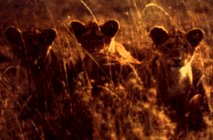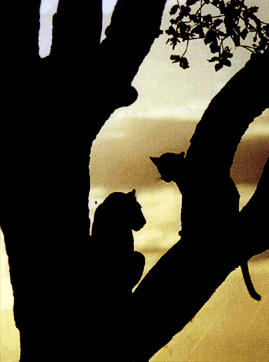
An African lion dozes in artificial slumber as NIH scientists work rapidly to collect its tissue, blood, and semen. From this mobile lab - a Range Rover, outfitted with microscope, liquid nitrogen, and pipettes, parked temporarily in a Tanzanian crater - the biological samples will be shipped to the laboratory of Stephen O'Brien, chief of viral carcinogenesis at NCI in Frederick, Md. Upon arrival, the materials gathered an ocean away will be examined by researchers for the presence of feline immunodeficiency virus - that is, if all the international paperwork for wildlife shipment is in order.
NIH researchers are learning, sometimes the hard way, that the U.S. Fish and Wildlife Service (FWS) and foreign customs officials are serious about enforcing regulations that require proper documentation for the import and export of live wild animals, as well as of the animals' tissues and body fluids. That's doubly true if the animal is a member of an endangered species.
 |
If NIH researchers need help to "fight their way through the quagmire of red tape" involved with shipping protected and unprotected wild species, Deborah Wilson, chief of NIH's Occupational Safety and Health Branch, advises them to contact the Quarantine Permit Service Office in Building 13, Room 3K04 (phone: 496-2960). The office has all of the necessary applications on hand, as well as staff trained to answer questions about the requisite permits. Wilson is also rewriting the chapter of The NIH Manual covering wildlife permits to make the regulations easier to understand. This thrust for education comes on the heels of recent minor violations by two NIH scientists.
Jean Decker, a chemist at NCI, recalls having a shipment of tissues from crab-eating macaque seized upon entry into England because of a missing permit. Decker immediately contacted the FWS, which was "cooperative and willing to help but not able to do anything once the box was out of the country." A glitch in paperwork resulted in the destruction of valuable research samples. Seizure is a tragic way to lose valuable data. But Cathy Bourne, an FWS wildlife inspector, notes that "foreign countries have the right to seize and destroy samples."
Bourne states that as far as researchers go, she hasn't had to deal with too many problems. Though the government believes that most research is an honest endeavor, critical paperwork must be complete and accurate. Paperwork is what Peter Nara, a scientist at NCI in Frederick, finds a frustrating impediment to science. However, he says, "I can appreciate both sides of the fence." As a veterinarian accredited by the U.S. Department of Agriculture (USDA), Nara is sworn to protect the United States and other countries from animal disease. As a researcher, he has found that the regulations "got in the way of doing things quicker." The time needed to fill out forms and wait for approval of shipments of chimpanzee blood slowed down his collaboration with Dutch scientists. In his eyes, the process could stand some improvement. He suggests the issuance of more blanket permits to cut down on paperwork. Bourne mentioned during an interview that blanket permits were being issued, especially to scientists who had demonstrated good compliance in the past.
In the United States, CITES permits are granted by the Department of the Interior's Office of Management Authority and enforced by the FWS. The permits, issued for the import or export of particular species, may be a one-time only or multiple-use permit depending on, among other things, the needs of the researcher and the available wildlife resources. These permits are required for the shipment of live endangered animals, their tissues, bodily fluids, cell cultures, genes, and proteins. Bourne suggests this rule of thumb for determining necessity of a permit: if the protected animal was invaded by any means (e.g. by a needle or electrode) when the biological sample was collected, then a CITES permit is required. By this measure, urine and fecal matter are exempt. Along with the CITES permit for shipment of endangered species, a scientist must submit an FWS Declaration of Importation or Exportation of Fish or Wildlife (Form 3-177) for any importation of wildlife. As implied by the form's title, the declaration is required for all wild animals, even those that are not endangered. Shipments of domesticated species, including dogs, cats, pigs, laboratory mice, and laboratory rats, are exempt from both CITES permits and the declaration.
 |
Most shipments of blood, tissue, and cell cultures of wild species are not inspected by the FWS, but by USDA and the FDA. However, their paperwork is assiduously checked by all agencies. Live animal shipments coming into the Baltimore-Washington International (BWI) or Dulles Airports are routinely inspected by Bourne and Potvin, who check for humane treatment during transport as well as the correct paperwork. Because the government can only monitor so many ports of entry and exit in the United States, certain airports are designated for the reception of foreign goods or the departure of native materials. For this region, BWI Airport is the designated port of entry. Shipments of wild animals should be routed through this airport. Dulles Airport is sometimes used by researchers sending or receiving wildlife shipments; however, this is not a designated port of entry. Another permit is required to use this nondesignated port. The nondesignated-port permit can be obtained directly from the NIH Quarantine Permit Service Office.
If all this sounds like too much work for a busy scientist, NIH's Wilson cautions, "There are penalties for not following the rules for both the scientists individually and the NIH." Researchers run the risk of fines, seizure of samples, or even destruction of samples at both port of exit and entry. One only has to glance around the office of the two regional wildlife inspectors to see the consequences of defying the law: two terrariums house heaps of Argentinian Choco tortoises seized during illegal importation.
Steps for International Wildlife Shipment
- J.M.K. |
Wildlife Designations at a Glance
- J.M.K. |